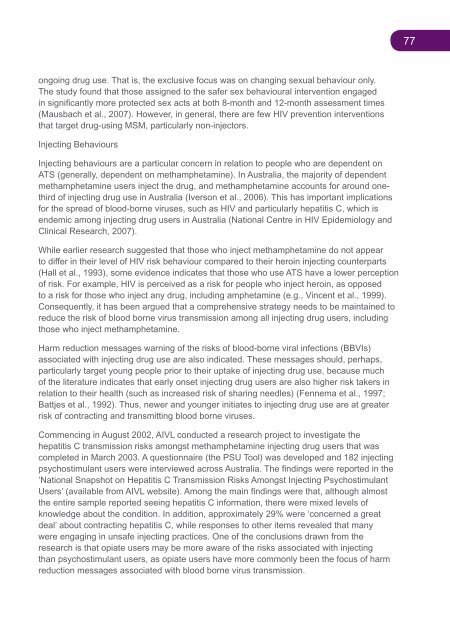National Amphetamine-Type Stimulant Strategy Background Paper
National Amphetamine-Type Stimulant Strategy Background Paper
National Amphetamine-Type Stimulant Strategy Background Paper
You also want an ePaper? Increase the reach of your titles
YUMPU automatically turns print PDFs into web optimized ePapers that Google loves.
77<br />
ongoing drug use. That is, the exclusive focus was on changing sexual behaviour only.<br />
The study found that those assigned to the safer sex behavioural intervention engaged<br />
in significantly more protected sex acts at both 8-month and 12-month assessment times<br />
(Mausbach et al., 2007). However, in general, there are few HIV prevention interventions<br />
that target drug-using MSM, particularly non-injectors.<br />
Injecting Behaviours<br />
Injecting behaviours are a particular concern in relation to people who are dependent on<br />
ATS (generally, dependent on methamphetamine). In Australia, the majority of dependent<br />
methamphetamine users inject the drug, and methamphetamine accounts for around onethird<br />
of injecting drug use in Australia (Iverson et al., 2006). This has important implications<br />
for the spread of blood-borne viruses, such as HIV and particularly hepatitis C, which is<br />
endemic among injecting drug users in Australia (<strong>National</strong> Centre in HIV Epidemiology and<br />
Clinical Research, 2007).<br />
While earlier research suggested that those who inject methamphetamine do not appear<br />
to differ in their level of HIV risk behaviour compared to their heroin injecting counterparts<br />
(Hall et al., 1993), some evidence indicates that those who use ATS have a lower perception<br />
of risk. For example, HIV is perceived as a risk for people who inject heroin, as opposed<br />
to a risk for those who inject any drug, including amphetamine (e.g., Vincent et al., 1999).<br />
Consequently, it has been argued that a comprehensive strategy needs to be maintained to<br />
reduce the risk of blood borne virus transmission among all injecting drug users, including<br />
those who inject methamphetamine.<br />
Harm reduction messages warning of the risks of blood-borne viral infections (BBVIs)<br />
associated with injecting drug use are also indicated. These messages should, perhaps,<br />
particularly target young people prior to their uptake of injecting drug use, because much<br />
of the literature indicates that early onset injecting drug users are also higher risk takers in<br />
relation to their health (such as increased risk of sharing needles) (Fennema et al., 1997;<br />
Battjes et al., 1992). Thus, newer and younger initiates to injecting drug use are at greater<br />
risk of contracting and transmitting blood borne viruses.<br />
Commencing in August 2002, AIVL conducted a research project to investigate the<br />
hepatitis C transmission risks amongst methamphetamine injecting drug users that was<br />
completed in March 2003. A questionnaire (the PSU Tool) was developed and 182 injecting<br />
psychostimulant users were interviewed across Australia. The findings were reported in the<br />
‘<strong>National</strong> Snapshot on Hepatitis C Transmission Risks Amongst Injecting Psychostimulant<br />
Users’ (available from AIVL website). Among the main findings were that, although almost<br />
the entire sample reported seeing hepatitis C information, there were mixed levels of<br />
knowledge about the condition. In addition, approximately 29% were ‘concerned a great<br />
deal’ about contracting hepatitis C, while responses to other items revealed that many<br />
were engaging in unsafe injecting practices. One of the conclusions drawn from the<br />
research is that opiate users may be more aware of the risks associated with injecting<br />
than psychostimulant users, as opiate users have more commonly been the focus of harm<br />
reduction messages associated with blood borne virus transmission.

















